Originally published by EarthSky.
Observing update for Comet A3!
Comet C/2023 A3 (Tsuchinshan-ATLAS) is increasing in brightness. And observers around the world are reporting that as of this weekend, they’re starting to just barely detect the comet with the unaided eye. Even the tail is visible without optical aid. However, Comet A3 is not yet obviously visible to the unaided eye for most casual observers. But the best should be yet to come!
Currently, binoculars provide the best views of the magnificent tail and nucleus. On recent mornings, the tail looks quite long. You can even take your own measurements of how long the comet’s tail looks. For example, if you take a good look through a pair of binoculars that has a 5-degree field of view, and you can see the tail extending about 3/5 of that field, you’re seeing around 3 degrees of the tail. And that means you are seeing with your own eyes a cometary tail that looks as long as six moon diameters!
Helpful tips to spot the comet
If you’re having problems finding the comet, first make sure you’re looking at the correct direction and time. During the final days of September and up to around October 1 and 2, Comet A3 is visible very low near the eastern horizon just before sunrise. Start looking when the sky is still dark, but close to dawn, or 45 to 60 minutes before sunrise. Make sure there aren’t hills, trees or buildings blocking your view east.
Another alternative is to use your cell phone’s camera. Most cell phone cameras provide a night or low-light mode. But it requires the camera to be firmly held or leaned against a fixed object to avoid shaky or blurred images. So take a few pictures facing east just before sunrise. These images accumulate the light for a few seconds, helping the comet show up clearly in your images.
As you review the images, zoom in to get a better look and bingo, you’ll find the comet. Then, after knowing exactly where the comet is, you can take new, closer images or at different magnifications. Although the comet may appear small in wide angle images, the resolution may appear good enough.
Once you’ve located the comet, take a good look at that area in the sky. You may discover that, in fact, you can see both the comet and its tail with your eye alone.
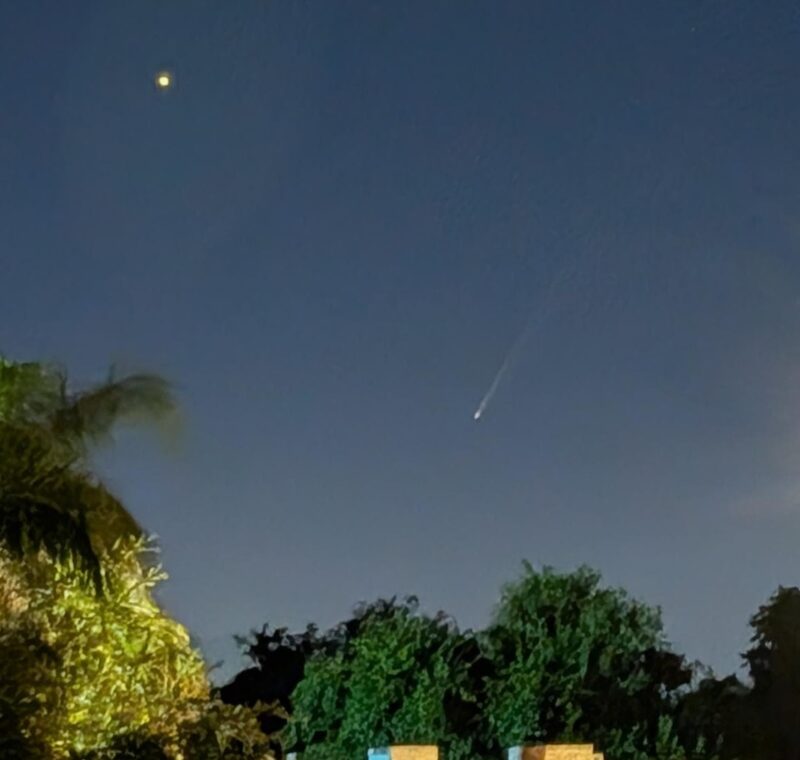
Victor Rivera took this image of Comet A3 using just his cell phone camera on Saturday, September 28, 2024, in Isabela, Puerto Rico. Used with permission.
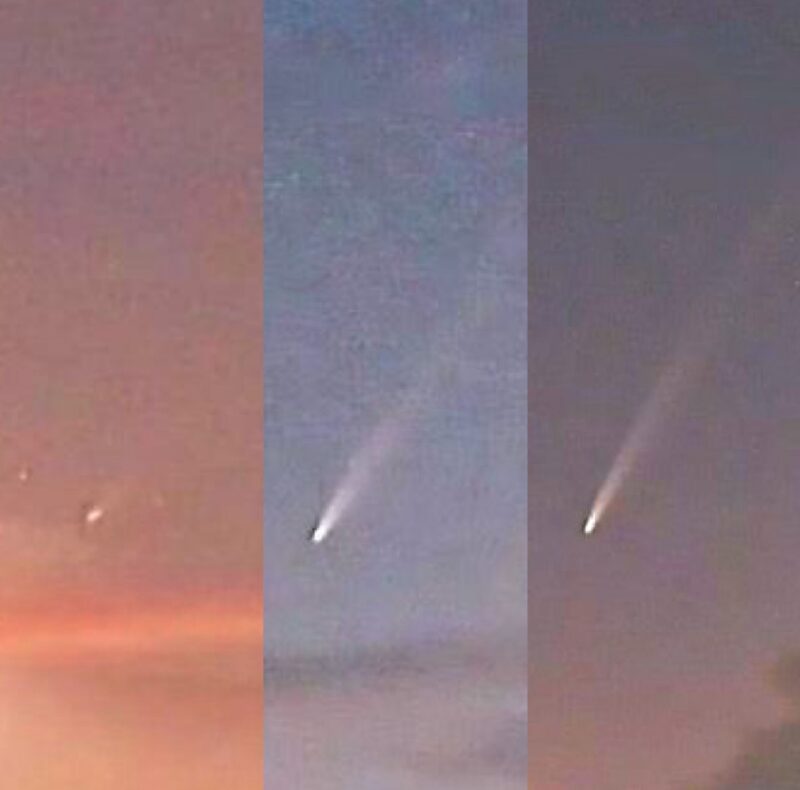
Eddie Irizarry took these 3 images of Comet A3 – one every 2 days this week – showing the tail looking increasingly longer. Used with permission.
A bright comet for September and October?
The rumors of Comet A3 Tsuchinshan-ATLAS’s demise were premature. Earlier in 2024, there were reports that the comet was breaking up. But instead, the comet is now coming into morning skies and appears to be in good shape. Its current brightness would put it just within reach of the unaided eye from a dark country site, at magnitude 3. With ordinary binoculars, it should be possible to pick out now. And it’s getting brighter.
Despite the previous reports that the comet might be disintegrating, the latest observations by sun-observing satellites and amateur astronomers indicate the comet is still very much alive. In fact, comet expert Terry Lovejoy was able to photograph the comet on the morning of September 11, 2024, from Queensland, Australia. He used a camera with a 135mm f1.8 lens.
Meanwhile, observer Colin Drescher was also able to capture some of the first recovery images using just a small digital telescope. And other reports of the comet are coming in from Atlanta, Georgia, to Chile and Puerto Rico.
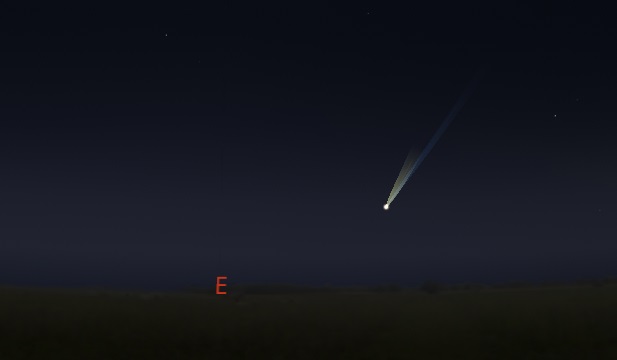
Here’s Comet A3 as it will be seen from Miami, Florida, around September 27, 2024. On this date the comet is at perihelion, or closest to the sun. To see it, face east just before sunrise with an unobstructed view to the horizon. In case the comet is still too dim to be visible to the unaided eye during perihelion, better opportunities should occur around mid-October, when the comet is closest to Earth and thus brighter. Image via Eddie Irizarry/ Stellarium.
How bright will it get?
Comets are unpredictable. And there’s no way to know at this time exactly how bright Comet A3 will become. But preliminary estimates suggest it might reach magnitude 4 to 3 (the lower the number, the brighter) around the time of its closest approach to the sun – or perihelion – on September 27.
The exciting part might come afterwards. It could grow as bright as magnitude 2.5 to 2 during closest approach to Earth on October 12. Or maybe even slightly brighter if we are lucky (or fainter if we’re unlucky), since comet behavior is so difficult to predict.
So Comet A3 isn’t going to be a Comet of the Century. But if it continues to perform well, it might be the brightest comet of the year.

Efrain Morales captured this image of Comet A3 Tsuchinshan-ATLAS from Puerto Rico on July 8, 2024. Image via Efrain Morales/ Eddie Irizarry.
How to see Comet A3 in September
Observers in the Southern Hemisphere had the best seats to view the comet during the first half of September. Observers closer to Earth’s equator will get their first opportunities by the end of the month.
One caveat: observers would require a clear, unobstructed view of the eastern horizon.
By the end of September, Comet A3 will gradually make the transition from the brief dawn appearance to the western skies at dusk. It may become visible starting around October 12, which is the date of closest approach to Earth. If it survives its encounter with the sun, the comet should put on a good show by mid-October.
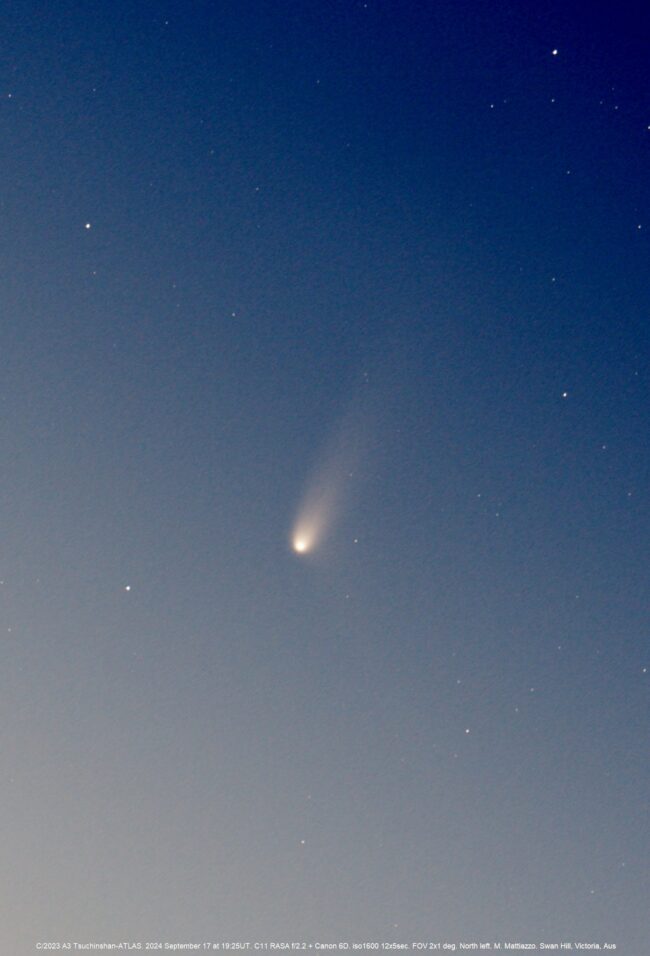
Michael Mattiazzo captured this image of Comet A3 from Australia on September 17, 2024. Thank you, Michael! Used with permission.
Comet A3 in October
After the comet gets closest to the sun, it will swing around near Earth. But as it does so, it passes almost directly between Earth and the sun, making it challenging to view. In early October, the comet will be in the dawn sky in Leo and near the constellations Hydra and Crater.
Starting from October 13 to 14, Comet A3 will be easier to spot on the following evenings. That’s thanks to the comet’s great speed, which will cause it to appear higher in the western sky on the following nights.
Then in late October, as it appears on the other side of the sun, it will move into the evening sky, passing through Serpens Caput and into Ophiuchus.

The turquoise line represents the path of Comet C/2023 A3 into the inner solar system. The comet will be closest to the sun on September 27, 2024, and closest to Earth in October 2024. Image via University of Arizona/ CSS/ D. Rankin.
Finder charts for Comet Tsuchinshan-ATLAS
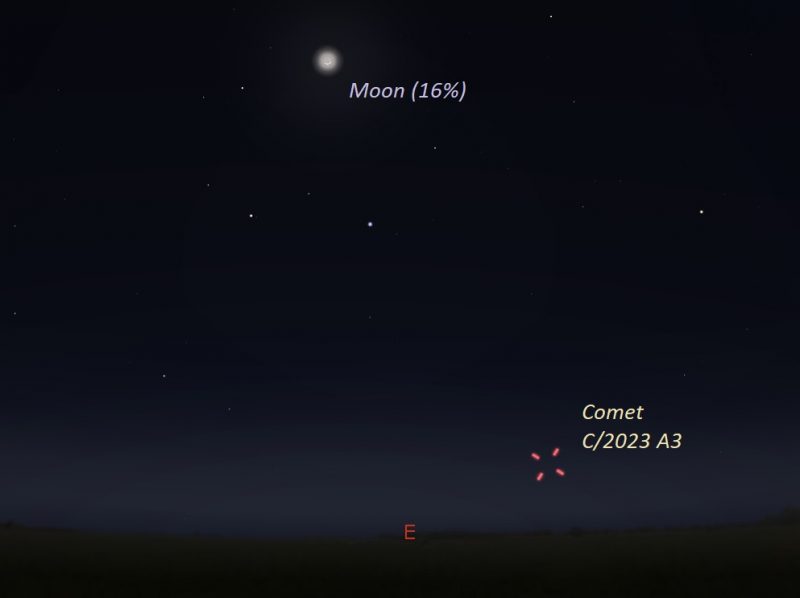
Comet C/2023 A3 on September 27, 2024 (perihelion). Facing east just before sunrise. Illustration by Eddie Irizarry using Stellarium.
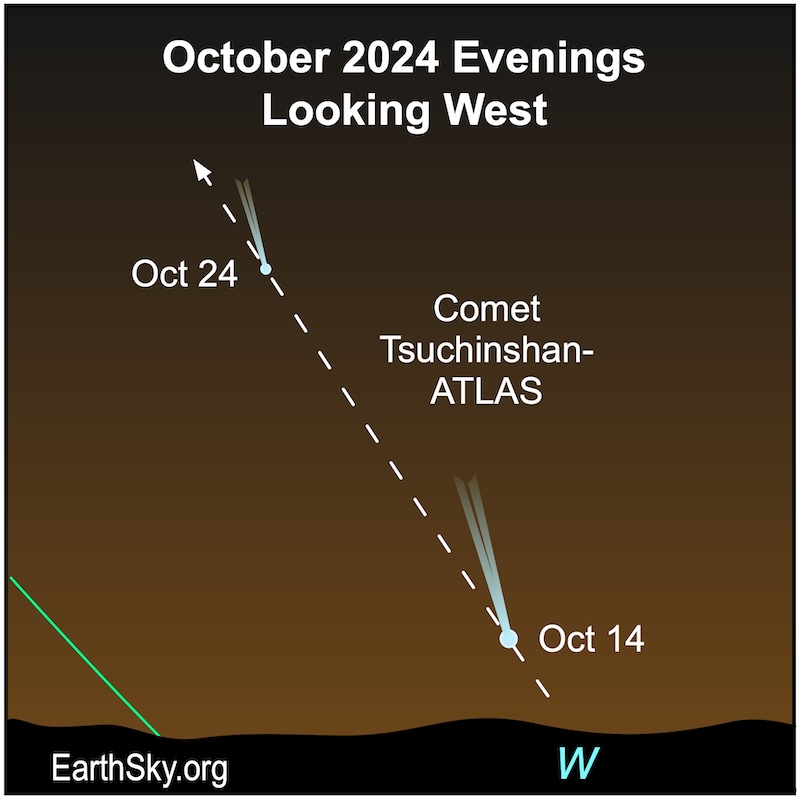
If we are fortunate, the comet will grace our sky from October 14 to 24. Look to the west shortly after sunset for Comet Tsuchinshan–ATLAS. Chart by John Jardine Goss/ EarthSky.
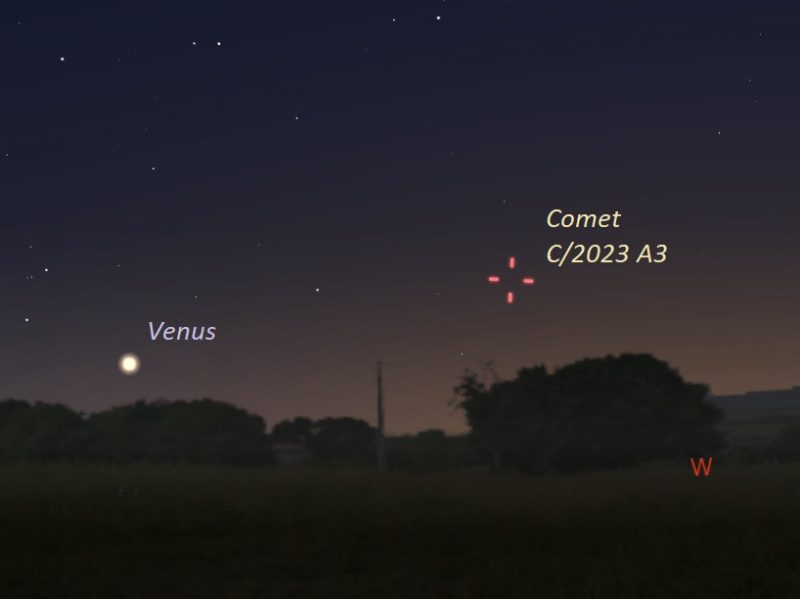
Comet C/2023 A3 on October 14, 2024, one day after closest approach to Earth. Facing a western unobstructed horizon just after sunset. Illustration by Eddie Irizarry using Stellarium.

Around October 17, 2024, comet C/2023 A3 (Tsuchinshan-ATLAS) might be easier to see in the western sky, as the comet gets higher each subsequent night. Illustration by Eddie Irizarry using Stellarium.
A speedy ball of ice and dust
Comet Tsuchinshan-ATLAS is blazingly speedy. It’s tearing through the inner solar system at 180,610 miles per hour (290,664 kph) or 80.74 km per second relative to Earth. With a small telescope, you can actually see its amazing speed. You can watch the comet’s location gradually change by comparing its exact position against background stars just 15 minutes later.
Comet A3 Tsuchinshan-ATLAS’s disintegration rumors
Comet A3 Tsuchinshan-ATLAS hasn’t been acting as people expected it to. As it was approaching the inner solar system in early 2024, it wasn’t brightening as much as expected. And then a study suggested the cometary nucleus was fragmenting.
The paper’s author, Zdenek Sekanina, a Czech-American astronomer and comet expert at NASA’s Jet Propulsion Laboratory, said, on July 8, 2024, that the comet entered an advanced phase of fragmentation. He said the end of Comet Tsuchinshan-ATLAS was inevitable.
However, comets are notorious for being erratic and unpredictable. And this one proved to be as well.
Discovery and naming
The Asteroid Terrestrial-impact Last Alert System (ATLAS) telescope in South Africa discovered Comet C/2023 A3 on February 22, 2023. Additionally, observers at Purple Mountain (Zijin Shin or Tsuchinshan) Observatory in China found the comet independently on images from January 9, 2023. Therefore, the comet also has the nickname Tsuchinshan-ATLAS.
At discovery, the comet was still 7.3 astronomical units (AU) from the sun, and shining at a dim magnitude 18.
Preliminary analysis of its trajectory suggests comet “A3” completes an orbit around the sun every 80,660 years.
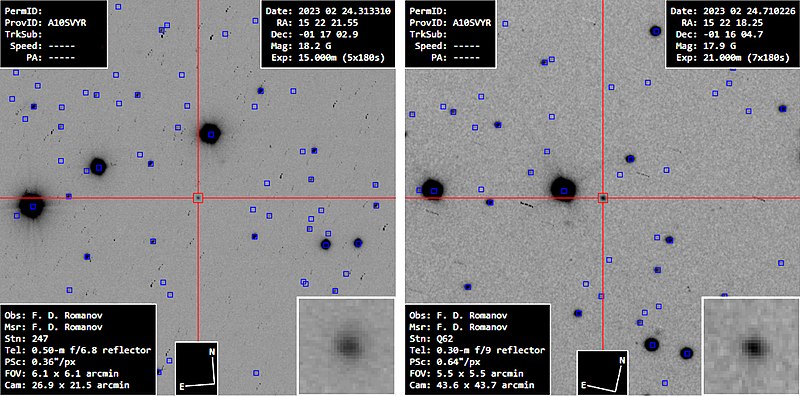
View at EarthSky Community Photos. | Filipp Romanov captured these images showing movement of the new comet, originally labeled A10SVYR, and now officially C/2023 A3. Filipp took these images confirming the new comet with remote iTelescopes in Chile and Australia on February 24, 2023. Thank you, Filipp!


